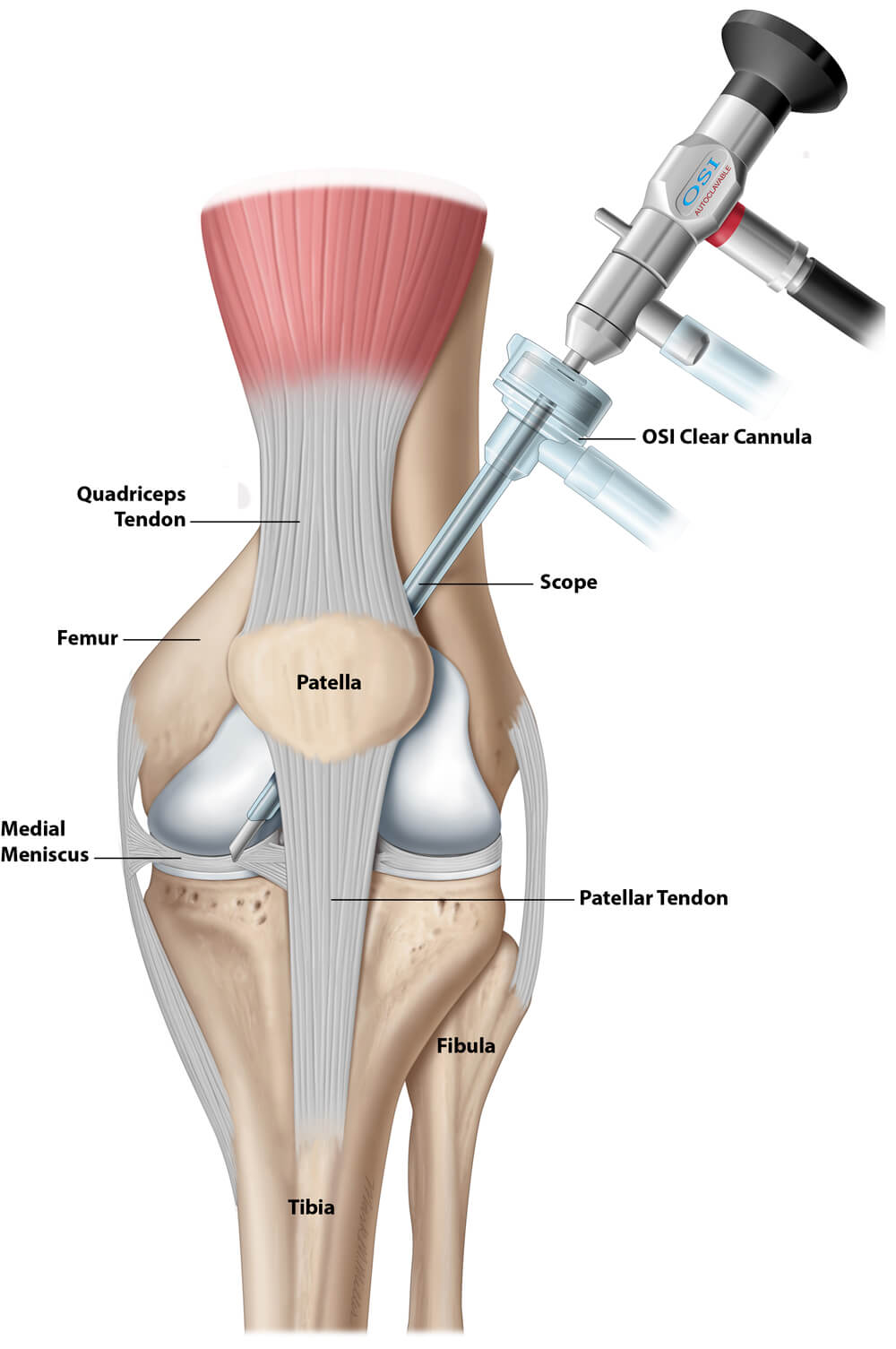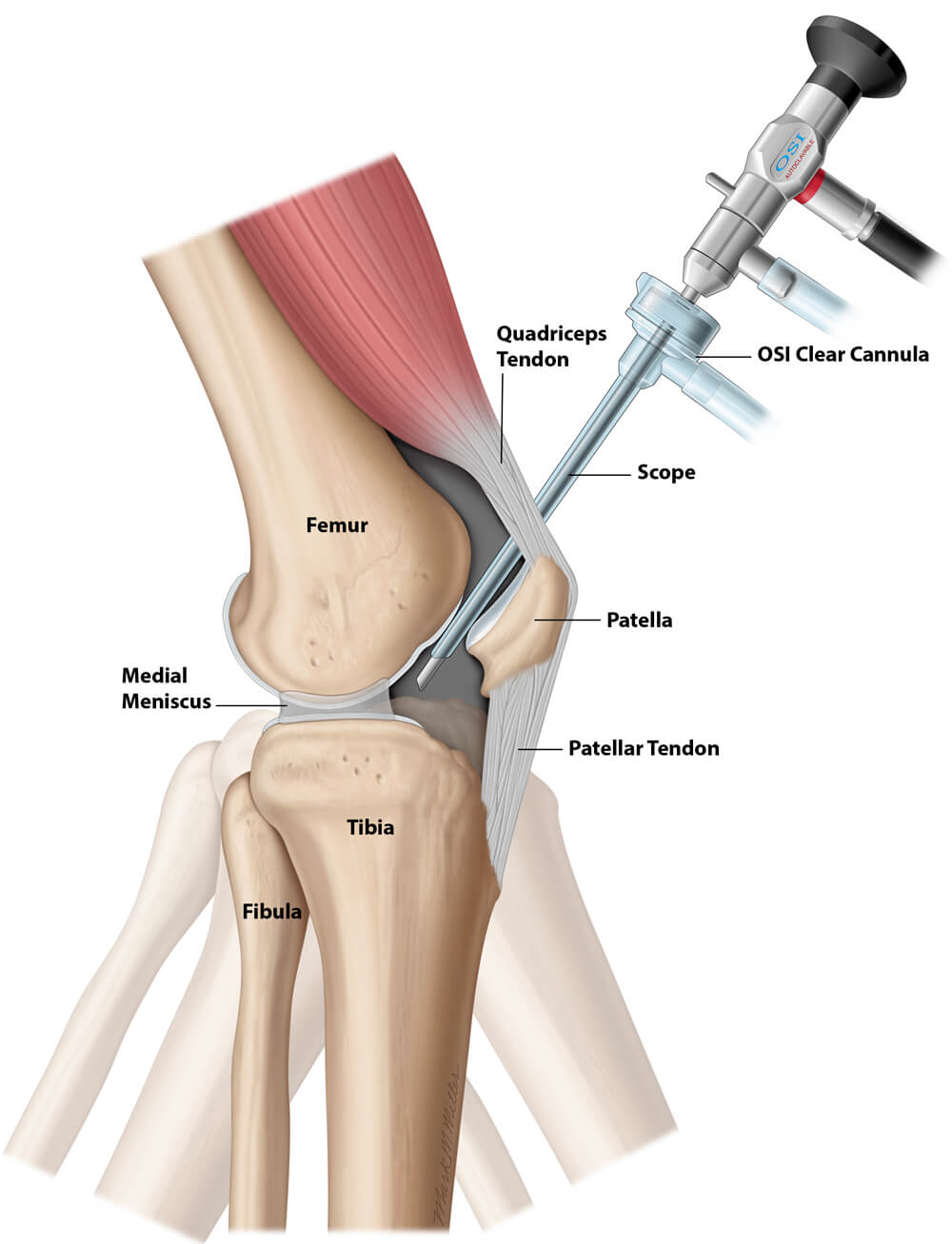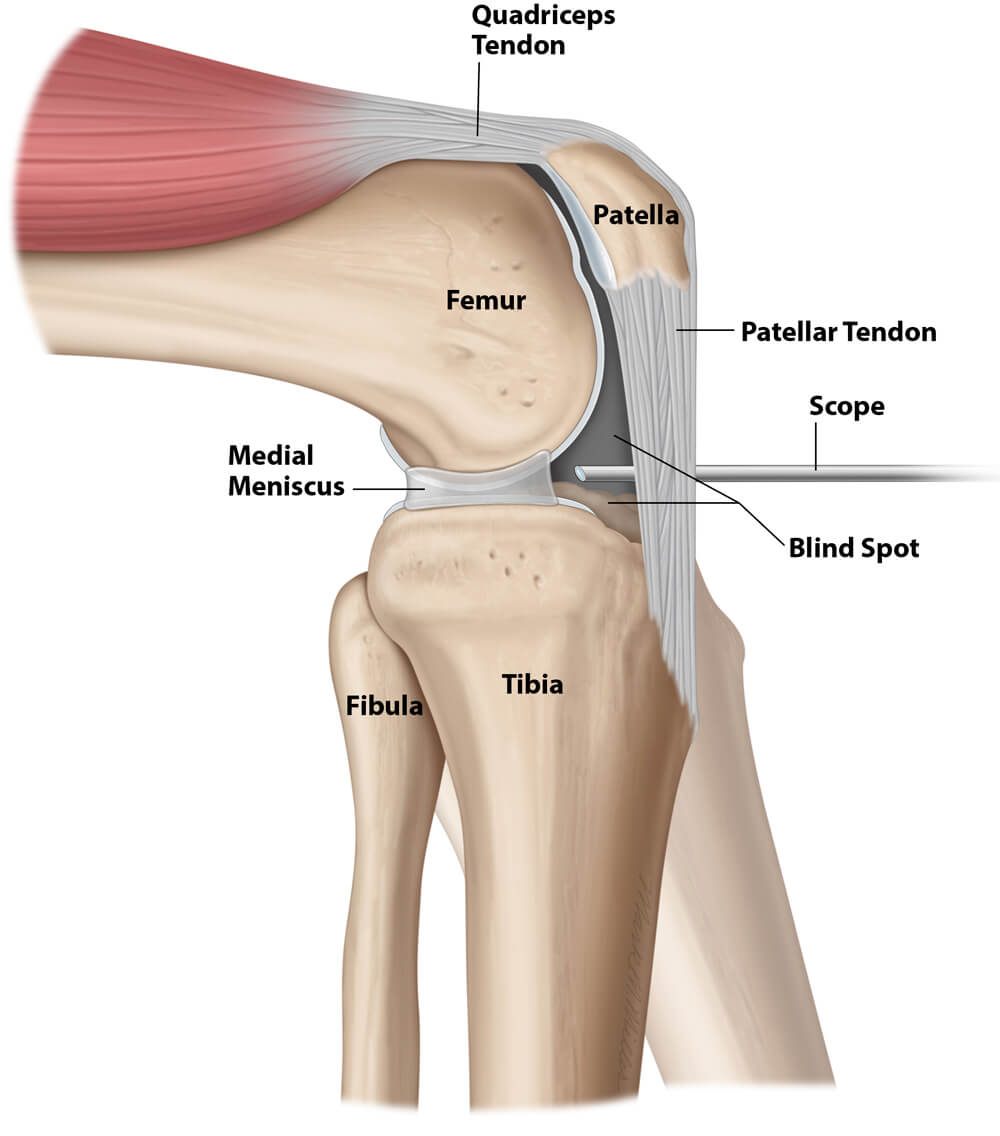An IA Saucerization of the knee is an advanced arthroscopy procedure that removes bone spurs and excess fat from the knee to eliminate pain and abnormal function of the knee joint while walking. A collection of bone and bone marrow, not a simple bone marrow aspiration, collected through a stab incision at the hip is converted into a bone graft slurry and then injected into the bone at the site of the excess fat, thus restoring the bone's health. The procedure also smooths over the cartilage and repairs the menisci and ensures their proper function. The surgeon must use unique entry portals into the knee; thus, the procedure requires the use of specialized arthroscopes and products designed by Orthopedic Sciences. The patient can go home on the day of surgery, and no incision is larger than 3mm. See our Patient Stories and note that our products have been used for over 20 years.
The more popularly known knee arthroscopy for osteoarthritis with a meniscus tear does not thoroughly clean and reshape the knee bones to as near normal as possible, nor does the procedure aim to ensure proper meniscus function. Currently available arthroscopic equipment is NOT designed to achieve this objective. Further, orthopaedic surgeons performing arthroscopy for osteoarthritis with a meniscus tear do not do so with an understanding of how fat under pressure within the bone causes the osteophytes to form. See Figures 9A and 9B on our Knee FAQs page. Explore our web pages and carefully read through the information presented. Search the internet for information on saturated and trans fats and how they affect the health of your bones, watch our patient testimonials, be engaged with your healthcare, share our website (www.orthopedicsciences.com) with your doctor to ask the pertinent questions, and join our efforts to help you keep the joint you were born with.
The procedure also recontours the cartilage where it is torn and ensures proper function of the meniscus during walking by cleaning or repairing the meniscus and removing any osteophytes that block the meniscus from gliding backward and forward while walking. The function of the meniscus is assessed while in surgery, and it is never assumed that the primary problem with the meniscus is the tear observed on a preoperative MRI.
Osteophytes form when excess fat attempts to escape the bone. These osteophytes are easily seen on x-ray and have a characteristic shape resulting from knee motion. During an IA Saucerization, the surgeon also decompresses the thigh bone by releasing this excess fat from the bone using percutaneous intraosseous irrigation. Cancellous bone and bone marrow are taken from the hip above the knee and then injected into the bone to replace the excess fat. The cancellous bone and bone marrow injected into the bone improve the bone’s health and strength. An IA Saucerization should not be performed using traditional arthroscopes.1 Traditional arthroscopes lack the properties of OSI’s Q Arthroscopes designed to save joints. The skilled surgeon performs the IA Saucerization through two to three small incisions while repeatedly motioning the knee as if the patient were walking. Fluoroscopy should be used during surgery as well. On the morning of surgery, the patient is asked to mark the most painful areas of the knee. This helps the surgeon focus immediately on the most painful parts of the knee during surgery. The blood pressure and heart rate are monitored for abrupt changes indicating that the areas being cleaned/reshaped contribute to the pain experienced by the patient. These painful areas are matched to the ink markings placed on the skin by the patient. The surgeon correlates the arthroscopic findings with the patient’s history, physical examination, x-rays, and MRI and ensures that the anatomy of the knee is restored to as near normal as possible and that the menisci are moving backward and forward smoothly after their cleaning or repair. The surgery can be performed with or without a tourniquet.
Additionally, OSI’s specialized bone grafting system for joint preservation allows the surgeon to collect autologous cancellous bone and bone marrow through a two to three mm incision at the hip. Your doctor may require you to use crutches for two to four weeks after surgery, and home exercises may be equally as effective as outpatient physical therapy. A continuous passive motion machine (CPM) or any other apparatus is usually not required. Given the very small incisions, significant scarring after surgery is unlikely. Most patients can go home on the day of surgery.
The following steps comprise an IA Saucerization of the knee:
An IA Saucerization cleans and reshapes the inside of the knee and restores the biology to the bone. Basic arthroscopy for osteoarthritis is often performed as a procedure to correct mechanical problems in the knee that cause pain and locking of the knee. The underlying problems within the knee are not addressed, namely, the excess intraosseous fat and oxLDL. Additionally, the procedure is NOT performed to prevent a total knee, but rather to delay the total knee. The IA Saucerization is performed with the view that the excess fat and oxLDL must be released, the menisci must be repaired or debrided, the contours of the bone must be returned to near normal as possible, and bone graft and bone marrow must be injected into the bone where the excess fat and oxLDL have been removed. The IA Saucerization of the knee views the knee joint as the end-organ of the femur, as Fremont Chandler considered the femoral head as an end-organ, albeit related to its blood supply. Using OSI’s system, all of the harvested cancellous bone and bone marrow can be percutaneously injected into the knee bones after it has been irrigated, and there is no waste. See our Patient Stories. After this reading, we are certain that others will begin to recommend or promote their bone marrow concentrating products for injecting bone marrow concentrate into the bone after arthroscopy. But here again, the oxLDL and excess fat should be removed along with the removal of all osteophytes to the extent possible. The indications to perform an IA Saucerization of the knee for osteoarthritis may be the same as those for performing basic arthroscopy of the knee for osteoarthritis with a meniscus tear. Basic arthroscopy for osteoarthritis with a meniscus tear addresses the torn meniscus and may also include a degree of debridement of other structures. Even if the surgeon intends to perform extensive debridement of the knee and does so, traditional arthroscopic equipment and techniques, having been developed in the 1970s, do not fully allow this to be accomplished. Peer-reviewed publications on such debridement do not describe the quality of the debridement performed but conclude that debridement is not effective.1,2 Additionally, when performing basic arthroscopy, no efforts are made to address the health of the bone or the process that led to the formation of the offending osteophytes. In the case of an IA Saucerization of the knee, the surgeon inserts the arthroscope at the top of the knee beneath the patella through OSI’s patented Clear Cannula. The inside front, sides, and back of the knee can be observed. The OSI Clear Cannula elevates the patella to improve visibility without damaging it. See Figures 1 and 2.


The Q Arthroscope and Clear Cannula allow the surgeon’s assistant to motion the knee during surgery as if the patient were walking or stooping. This motion aids in locating the areas that make the knee snap, lock, or pop and cause pain. In contrast, a traditional arthroscope is inserted below the patella in the front of the knee. The surgeon cannot see behind the tip of the arthroscope (blind spots) nor how the tibia and menisci move along the femur while walking because the arthroscope must move as the doctor moves the tibia. See Figure 3.

Inserting a traditional arthroscope at the top of the knee may damage the cartilage because these arthroscopes are too short and too large. Even if inserted safely, a traditional arthroscope does not provide the surgeon with the non-digital 3D images required for a successful IA saucerization, as does OSI’s Q Arthroscopy system with Clear Cannula. For many years, the deficiencies of traditional arthroscopes have not been recognized because most arthroscopists consider themselves excellent technicians when performing arthroscopy, and the goal of surgery is frequently to “repair or clean the torn meniscus,” with meniscus tears being considered a sports injury or a “degenerative” tear. As a result, arthroscopy for osteoarthritis with a meniscus tear is commonly performed with much ongoing debate about its effectiveness. The IA Saucerization requires using OSI’s patented arthroscopic equipment and cannulas to create a non-digital 3D view of the inside of the knee joint. OSI developed its arthroscopy system to improve the debridement of the knee joint, not to resolve the debate of the effectiveness of arthroscopy among professionals. Patented specialized burrs and shavers allow access to the back of the knee to reshape the bones and cartilage so the meniscus can glide along the cartilage as it should. See our Safety PX video under Cartilage Surface Products. Standard arthroscopy equipment does NOT allow the surgeon to complete an IA saucerization of the knee successfully and should not be attempted. Doing so will lead to exacerbation of the pain experienced by the patient.
Experts differ on whether knee arthroscopy is a worthwhile treatment option for knee osteoarthritis. Many experts comment on clinical studies suggesting knee arthroscopy does NOT benefit patients with knee osteoarthritis.1,2 Some surgeons argue that because knee arthroscopy is less invasive, it is worth trying before moving forward with a more invasive irreversible total knee replacement. It is important to note that the clinical studies that reported no benefit from arthroscopy do NOT describe decompressing the fat within the bone. These clinical studies used traditional equipment and techniques that included lavage (washing the knee out with saline) and removing osteophytes that were immediately visible or free-floating inside of the joint. Many other structures may have been debrided as well. However, these clinical studies make a large assumption about the quality of the surgery performed and remain silent on how osteophytes form and how they may block the motion of the menisci. These studies do NOT comment on how the inaccessibility of various osteophytes represents a limitation of the equipment or the surgeon's skill. Further, these clinical studies do not discuss how the meniscus function may have or may not have improved after its repair or the debridement of any meniscus-blocking osteophytes. More importantly, no mention of how intraosseous (within the bone) fat may cause pain, pressure, or weakening of the bone in any stage of disease. The IA Saucerization reshapes the bones and removes nearly all osteophytes to the extent possible, releases the excess fat that blocks the inflow of blood, improves the quality of the bone with an injection of autologous cancellous bone and bone marrow into the femur and tibia, and restores the function of the meniscus. Well-known knee injections for osteoarthritis call for the chosen medicament to be injected into the joint, assuming the cartilage or its age-related degeneration (senescence) is the sole and primary cause of disease.
Joint replacement of the knee is cleaning of the knee that is so extensive an artificial joint must be inserted in place of the normal knee joint. Thus, can the knee be cleaned just as thoroughly without having to replace the knee if disease is treated early? Nonetheless, the surgeon may perform the replacement in a traditional manner or use the assistance of a robot. When cleaning the knee this extensively, all osteophytes are removed, and the femur, by nature of the procedure, is decompressed of the excess fat; see this link https://www.youtube.com/watch?v=3TzNfpatwN0 at 4:38 - 4:40 and notice the fat released from the femur as a large drill bit is inserted into the femur. The fat is released from the thigh bone (femur) during what is called preparation for instrumentation as a large drill bit (seen in the video) is drilled into the femur.
Further, the cuts of the bone must follow a particular pattern so that the artificial components can be attached to the femur, the tibia, and the patella. Also, closer inspection of the bone after the cuts are made often reveals a yellow color consistent with a significant amount of fat in the bone. Sclerotic areas representing calcified marrow spaces (see OSI White Paper) may be seen. Fixation to the implant is often poor in these areas; thus, a treating surgeon is likely to pie-crust these areas of sclerotic bone to improve the flow of the fixation cement into the bone. The components may be fixed to the bone with or without cement. Six hundred thousand knee replacements are performed each year in the US.
The most common causes of joint pain reported in published research are aging, injury, or repeated stress on the joint. Many different conditions are associated with joint pain, including:
Avascular necrosis (osteonecrosis) is a disease resulting from the temporary or permanent loss of the blood supply to the bones. Without blood, the bone tissue dies. If the disease process involves the bones near a joint, collapse of the joint surface may occur. Avascular Necrosis is also known as aseptic necrosis, ischemic bone necrosis, or osteonecrosis.
Bone marrow edema (also known as bone marrow edema lesions) occurs when an area of bone is injured. In the case of degenerative disease, localized fat accumulations express oxidized low-density lipoproteins, oxLDL (Bad Cholesterol), which may lead to inflammation of the bone. The bone is weakened and may fracture internally (intraosseous insufficiency fractures). This discussion is not to include transient osteoporosis of the hip or the bone contusion seen with an ACL tear. Significant pain is often associated with these degenerative bone marrow edema lesions, and lesions in their early stage of development may get the attention of a treating physician because of their obvious appearance on MRI. These more obvious lesions lead to some kind of treatment, usually the injection of a calcium phosphate composite or some other synthetic bone graft substitute. However, these simple injections do not address the removal of oxLDL and pro-inflammatory cytokines from the bone. The less than obvious lesions on MRI go undetected for many years and may form large osteophytes associated with meniscus tears.
Joint preservation is a subspecialty within orthopedics in which surgeons perform procedures designed to preserve a patient’s natural joint rather than replace it. Remember that joint preservation can include surgery on the joint surface and the bone during a single procedure. See our Questions to Ask a Doctor.
Joint preservation is important because it addresses more than just a meniscus tear or frayed cartilage. The procedure offers obese and normal-weight patients an opportunity to preserve their joints. Instead of masking an ”unknown” cause for joint pain, joint preservation corrects identifiable abnormalities during a single procedure called an Intraarticular Saucerization with an Irrigation Osteoplasty. The Intraarticular Saucerization procedure does NOT include correcting bowed legs or knocked knees. Many patients are interested in preserving their natural joints. However, preservation does not mean keeping a knee joint that is painful and non-functional. This is why it is important to talk to your doctor early about your joint pain. Joint preservation is important because it requires the patient to recognize that the fats they eat accumulate in the bones and contribute to the development of osteoarthritis with the expression of oxLDL in the bone. OxLDL can lead to calcification (occlusion/clogging) of bone marrow spaces within the bone. This leads to bone death and joint destruction. Recognizing this early allows the patient and the doctor to work together to preserve the joint. Joint preservation and the IA Saucerization require your doctor to recognize how osteophytes form, how they block normal meniscus function and cause abnormal joint motion, how to identify these blocking osteophytes on MRI, and how excess fat and oxLDL contribute to disease. The surgeon must address these issues and any meniscus tear or cartilage damage during a single arthroscopy procedure with or without a tourniquet. If a reader hereof wants a quick answer from a few short bullet points on an attention-grabbing web page, joint preservation may not be for you; the same holds true for a treating physician. There are no quick and simple answers to understanding the complexity of the human knee. The medical literature is replete with treatment modalities short of a knee replacement. The IA Saucerization procedure, the first of its kind, is a minimally invasive arthroscopy procedure that substantially improves upon routine arthroscopy by using more advanced equipment and focusing on releasing fat from the bone (as is the case in a total knee) and the removal of all osteophytes to the extent possible. The procedure also includes reshaping the knee bones to near as normal as possible, combined with a meniscus repair and autologous bone grafting as may be necessary. See our Biomass Delivery Curette videos. All of the above is achieved percutaneously. The knee is a complex structure that can last a lifetime; thus, you must commit to keeping it. The patient must work with their doctor by eating a low-fat diet and avoiding large amounts of saturated fats in dairy products and trans fats typically used to prepare fried foods. Consume foods containing antioxidants,3 follow all postoperative instructions and begin, if not continue, a daily exercise program. Even if one were to have the knee replaced, a diet low in saturated fat is always beneficial. A caring surgeon recognizes that asking patients to make these kinds of lifestyle changes while the knee is swollen and painful may be difficult for some patients; thus, the physician and patient must work together as a team to save the knee with an Intraarticular Saucerization on the part of the surgeon and diet modification and exercise on the part of the patient. The disease must be recognized earlier than a noticeable meniscus tear with osteoarthritis. This requires a broader understanding of the disease when the patient first presents with joint pain.
Orthopedic Sciences, Inc. (OSI) has significantly contributed to the orthopedic industry and joint preservation through Dr. Brannon's confidence in questioning conventional wisdom. The answers we have obtained over 20 years enabled us to innovate, design, and develop products that improve upon the standard of care. Following our first endoscopically guided core decompression for avascular necrosis in 2002, we asked these fundamental questions: Why are the marrow spaces occluded with calcium in areas of the MRI that do not show classic AVN? Are occluded marrow spaces also observed in lesions that are diagnostic for AVN on MRI? What causes calcium to be deposited within these marrow spaces? It would have been easy to describe calcified marrow spaces as artifacts, particularly when one is not open to information that contradicts a strongly held belief or teaching. We pressed on, as the answers to these questions proved groundbreaking and have led to improved outcomes and reduced costs for patients with AVN and osteoarthritis of the shoulder, the hip, and the knee in patients aged 8 to 70. See our patient testimonials. OSI recognized that calcification of the marrow spaces was very similar to the calcification of the arteries in cardiovascular disease (CVD). We noted that in CVD, oxLDL within the macrophage (a cell that swallows the oxLDL) induced the trans-differentiation (the changing of one cell type into a different cell type) of vascular smooth muscle cells within the arteries around the heart into osteoblast-like cells (cells that lay down bone). The newly formed osteoblast-like cells are induced to deposit calcium phosphate in the tissues around the arteries and contribute to the formation of plaques within the arterial wall, sharing calcification mimicries with osteoblast. In the case of osteoarthritis and AVN, osteoblasts are already present within the bone. OSI notes that the information provided herein is NOT a scientific review but rather a summary of published peer-reviewed literature to help the public understand osteoarthritis, AVN, and the possible similarities these diseases have to CVD. In 1948, Fremont Chandler identified AVN as a coronary of the hip (Chandler’s Disease) 37 years before Brown and Goldstein were awarded the Nobel Prize for describing the mechanisms of cholesterol metabolism. Brown and Goldstein paved the way for understanding CVD and the ultimate characterization of oxLDL’s role in the calcification of coronary arteries. Notably, the calcified marrow spaces in AVN described by Freund in 19365 were observed endoscopically by Brannon in 2002.6 Brannon sought to understand the mechanism of marrow space calcification in AVN, and his efforts led to the discovery of elevated levels of hypoxia-inducible factor-1𝛼 (HIF-1𝛼) in patients with MRI negative and pathology positive AVN.7,8,9
This seminal observation, combined with detecting intraosseous oxLDL in bone marrow edema lesions in arthritic knees, strengthened our development efforts for products that remove osteophytes that contain fat and oxLDL. OSI also developed products to remove the necrotic burden (bone with occluded marrow spaces) within the bone by performing an Intraosseous Saucerization (core decompression with thorough debridement). The biology of the bone is then restored by injecting or packing autologous cancellous bone and bone marrow into the area where the dead bone was removed. Experts opine on “empty lacunae” as a hallmark of avascular necrosis. However, a blood supply must be present to remove the dead cells and empty the lacunae. A broader understanding of AVN and osteoarthritis describes the disease as a diffuse event within the bone versus a very localized event. Nonetheless, highly localized events within the bone may lead to AVN in some cases. When we choose to listen to a select few, contrary to the work of other experts, advancements in the treatment of avascular necrosis and osteoarthritis cannot be made.10
Check out our page on OSI Product Information for Healthcare Professionals to learn more about OSI Products.
Currently, surgeons depend on MRI or x-ray to locate necrotic bone within the femoral head. The Hip Tool Bone Graft Stabilization System, HTBGSS, and endoscopic bone debridement help orthopedic surgeons locate the necrotic bone and remove it. A significant advantage of the HTBGSS is that nearly all necrotic bone can be removed. After the necrotic bone is removed, The Hip Tool stabilizes the bone graft packed into the residual cavity. The stabilization allows early range of motion at 3 weeks to promote cartilage nutrition and prevent graft dislodgement. The Hip Tool implant also helps keep the joint surface elevated. The bone graft and bone marrow are obtained from the hip through a 2 mm incision. The Hip Tool incision is only 4 cm. Our system has been safely applied to the shoulder, hip, and knee for 20 years.
OSI’s Clear Cannula, shavers, and burrs allow surgeons to see the disease within the joint in 3D and access traditionally “difficult” areas within the joint. Further, the surgical technique of the Intraarticular Saucerization allows the surgeon to range the knee to ensure proper functionality of the meniscus after its repair. The excess fat within the bone is removed and replaced with autologous cancellous bone and bone marrow using OSI’s equipment.
This paper concludes that arthroscopy for osteoarthritis is not effective. However, these authors make no description of meniscus function after debridement nor removal of osteophytes that obstruct normal motion of the knee. The release of excess fat and oxidized LDLs are not described, only that the knee was debrided.
This paper is a follow-up to the Moseley et al. paper after the orthopaedic community considered Moseley’s statistical methods to be inadequate. Nonetheless, these authors concluded that arthroscopy for osteoarthritis was ineffective after performing inadequate debridement and using antiquated equipment, as in the Moseley paper. Again, the release of excess fat and oxLDL from the bone are not described.
